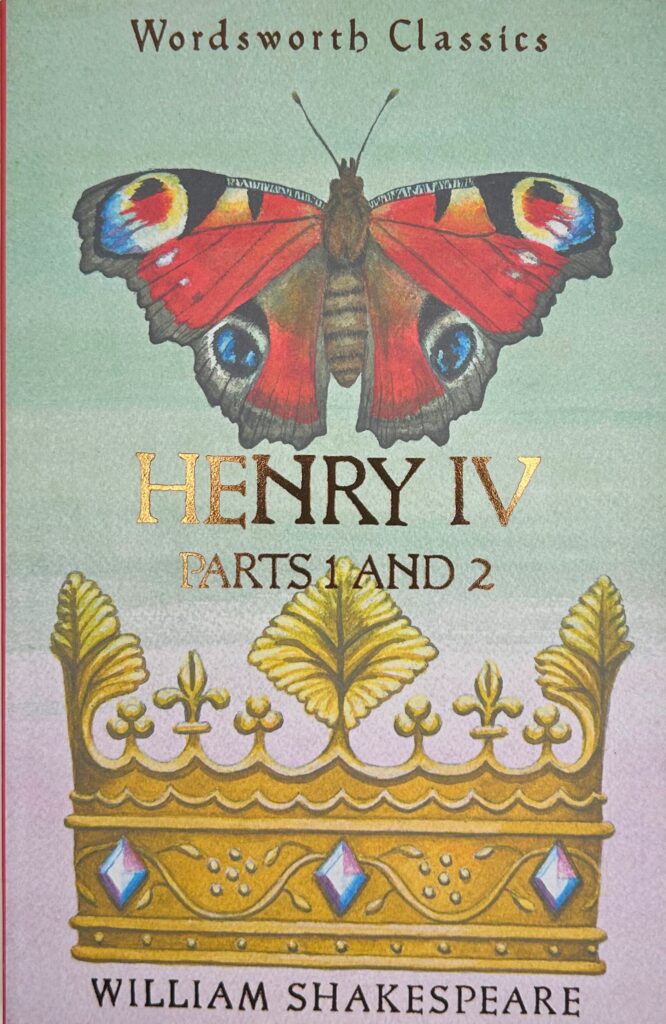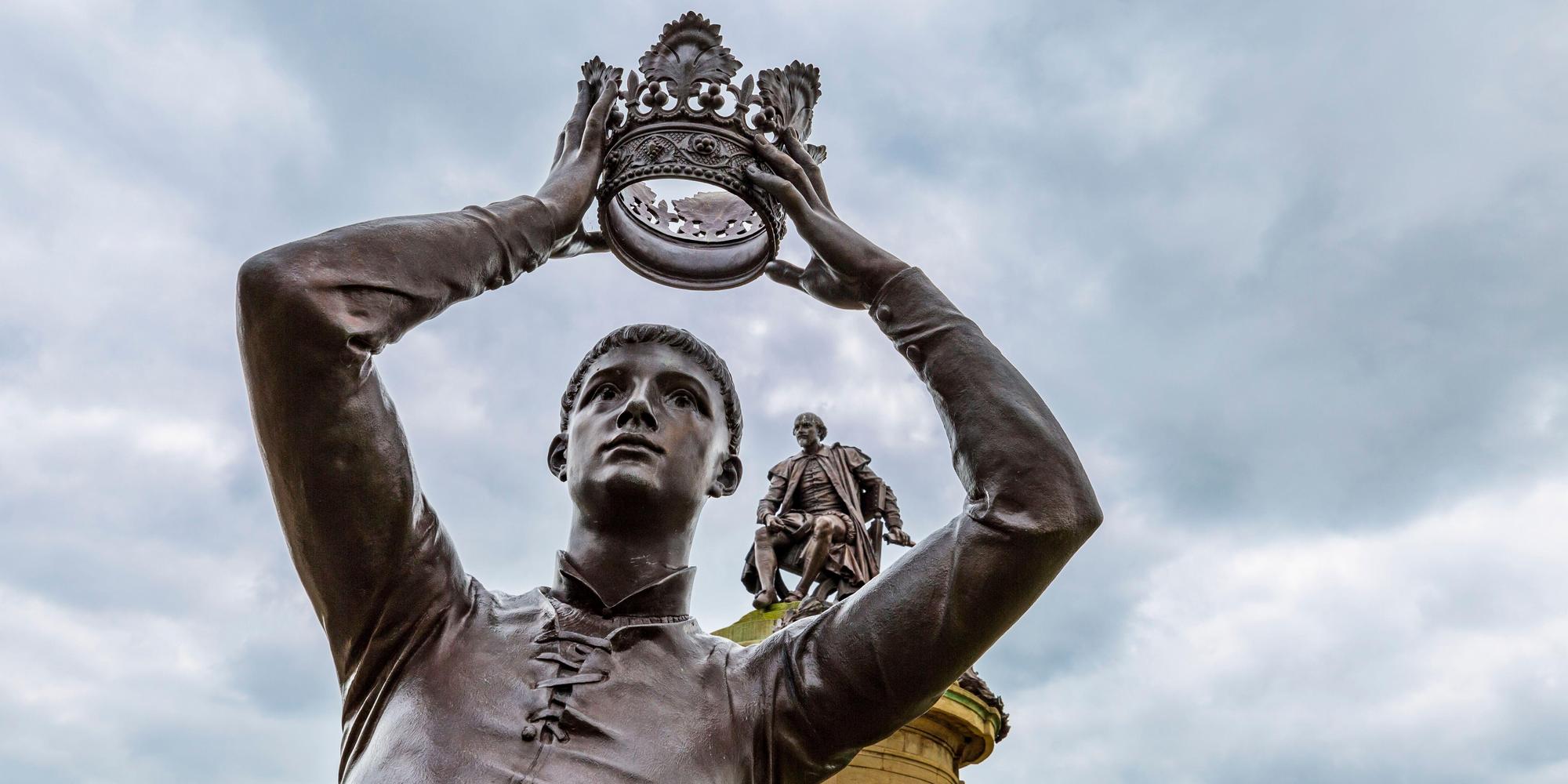
King Henry V
We Happy Few’: Agincourt, History, and National Myth: King Henry V
Few stories ignite the British sense of national pride and identity quite as much as those when a small but valiant force hold their ground against a much bigger enemy. This is what the Battle of Britain was all about, the Battle of Rorke’s Drift, and probably most importantly of all, the Battle of Agincourt, where Henry V led 9,000-odd soldiers to victory against a much larger French force in 1415. Henry’s army was made up mostly of yeoman archers, and while estimated numbers vary, the French army was anything from 15,000 to 30,000 strong, comprising armoured cavalry and infantry, around 6,000 of which were killed against English losses of barely 600, a staggering ratio of ten to one. King Henry V
In national myth, Britain standing alone against a superior force is a powerful symbol. Churchill evoked it perfectly in his Shakespearean speeches during the Battle of Britain, and it was certainly a central feature of the Brexit campaign, whatever your views might be on that. Henry’s victory crippled France as a dominant European power – in some cases three generations of French nobility died on that battlefield – and ushered in a new era of English military and political prestige. In many ways, he sowed the seeds of the great power England was to become under Elizabeth I, which ultimately led to the British Empire and the country’s position as a global superpower in the nineteenth century. Ripples were still being felt in the twentieth century, when the ghosts of Henry’s bowmen were said to have intervened during the British retreat from Mons, and when Churchill invoked Henry’s spirit in his rousing Second World War speeches, when all seemed lost and, once more, Britain stood alone. In 1944, Lawrence Olivier’s film version of Henry V prepared the population for D-Day. Henry V reaches across the centuries, one of the great English monarchs, immortalised by Shakespeare as ‘Prince Hal’ in Henry IV, Parts 1 & 2 and as the victor of Agincourt in Henry V: ‘Once more unto the breach, dear friends, once more…’
Henry’s position in our nation’s history would seem to be unassailable. Yet he is one of those iconic figures who has actually been crafted not from the historical record but from literature, in common with, for instance, King Arthur – a minor Celtic warlord elevated to mythic status by Norman chroniclers keen to cut the brooding Saxon bloodlines and link their man, William, to a more ancient and noble line; Robin Hood, a folk hero with no basis in reality whatsoever; and Dick Turpin, gentleman highwayman, a nasty and unremarkable eighteenth century thief whose legendary reputation can be ascribed almost entirely to the early Victorian romance Rookwood. The ‘Angels of Mons’ were an invention as well, a little propaganda piece for the London Evening News written by Arthur Machen in 1915; Machen was known for his esoteric supernatural and horror fiction. As Lady Clarinda’s asserted in Crotchet Castle, ‘history is but a tiresome thing in itself; it becomes more agreeable the more romance is mixed up with it.’ King Henry V
And the legend of Henry V shows no signs of abating. When it was reported a few years back that a film version of Bernard Cornwell’s novel, Azincourt, was in the offing, the Express framed the article with: ‘A triumph of the humble English and Welsh longbowmen over the arrogant French knights, it remains a vivid demonstration of the bulldog spirit, ingenuity and bravery against the odds we like to see as some of the finest qualities of our nation.’ (The film’s still in development hell, by the way.) And this was pretty much where Cornwell’s novel ended up as well, still following the myth. The man, however… Well, that’s a different story, which has little to do with redoubtable British spunk, courage, determination, or longbows.
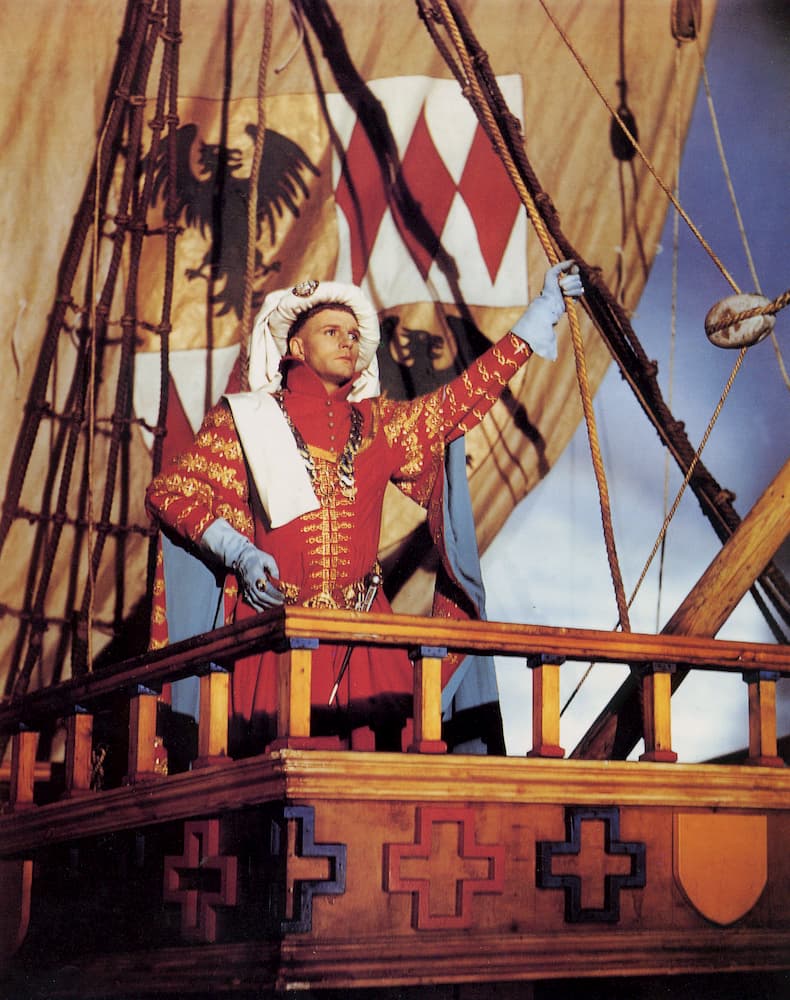
Laurence Olivier as Henry V
When most of us think of Henry V, I’d bet that the image that immediately comes to mind is of either Lawrence Olivier or Kenneth Branagh, depending on one’s age. To a lesser extent, the Netflix generation might also go to Tom Hiddleston or Timothée Chalamet. The story behind him will be that of Shakespeare, the wayward prince hanging around with Falstaff, Poins, Bardolph, and Peto until he comes into his own at the Battle of Shrewsbury, rejecting his old lowlife crew and becoming the warrior king of Harfleur and Agincourt. King Henry V
The real Henry’s life, though notionally on the same path as the stories, was very different. There was no riotous youth, and by the age of 14 he was already the High Sheriff of Cornwall and in command of a major part of the English armed forces. He gained valuable military experience during the Glyndŵr Rebellion in Wales, and in 1403, at the age of 16, he led his troops against the rebel army of Henry ‘Harry Hotspur’ Percy of Northumberland, fighting alongside his father, Henry IV. Percy was defeated and killed, but during the battle Prince Henry was shot in the face with an arrow, the three-inch iron bodkin point entering beneath his left eye and embedding itself in the back of his skull. Miraculously, the arrow missed the brainstem and the surrounding arteries and did not injure his eye. That said, this would still have been a death sentence for a common soldier, but Henry had the best medical care then available, in the form of the court surgeon John Bradmore. Also a brilliant metalworker, Bradmore designed a tool to extract the bodkin head after field surgeons broke the shaft of the arrow. He kept the prince anaesthetised with dwale, a mixture of henbane, hemlock, opium and wild lettuce seeds dissolved in alcohol and vinegar, using a glass squirtelle to blow wine through the wound to cleanse it, and honey as an antiseptic dressing. He sutured the wound with hair from a horse’s mane. Henry survived, but the scar was terrible, a florid trench running beneath his eye and down his cheek. He never permitted a full-face portrait, only his right profile, although later depictions in the sixteenth century and after omitted his disfigurement. Bradmore recorded an account of the operation in Latin in the Philomena, one of the earliest treatises on surgery. It is also mentioned in a Middle English surgical treatise attributed to Thomas Morstede, who led a company of surgeons during Henry’s French campaign of 1415.
Following his father’s death, Henry became king of England in 1413, reigniting the hot and cold Hundred Years’ War by asserting his right to the French throne as well. Henry’s great-grandfather Edward III had initiated this dispute after the death of his uncle, Charles IV of France, in 1328, leaving no direct male heir. Edward was the son of Charles IV’s sister, the formidable Isabella of France, and, as Charles had no sons or brothers, proclaimed that he was the next male relative in line. Since the tenth century, however, the French crown had always passed down through exclusively male lines – ‘agnatic succession’ – and Edward’s maternal ancestry was not deemed legitimate. This is the ‘Salic Law’ of the first Frankish King, Clovis, mentioned in the first act of Henry V. The throne instead passed to Charles’ cousin Philip, Count of Valois, who became Philip VI. Edward begrudgingly conceded, but further political disputes with France in 1337 over Edward’s Duchy of Aquitaine (Gascony) and the county of Ponthieu (part of the Province of Picardy in northern France) led Edward to press his claim again in 1340, triggering the war. Edward gave himself the title ‘King of France’, and this was also assumed by Richard II, Henry IV, and Henry V. The English kings were generally prepared to waive the claim, however, if the French would acknowledge their right to Aquitaine and other French lands according to the terms of the 1360 Treaty of Brétigny, with which Edward III and John II of France had ended the first phase of hostilities. King Henry V
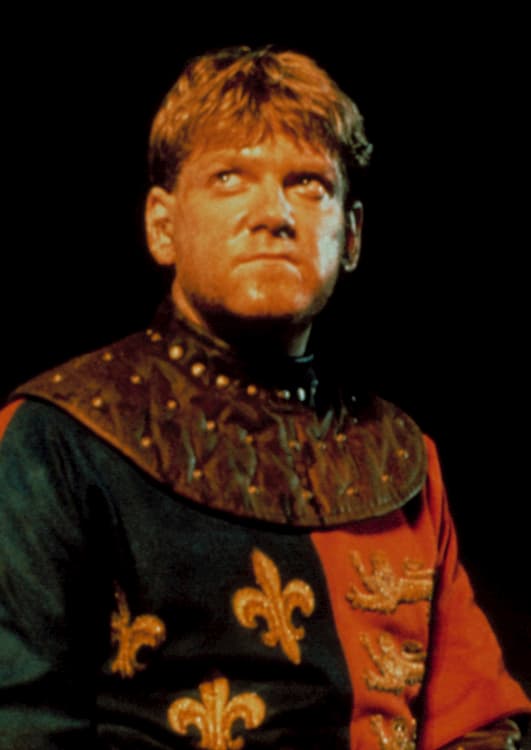
Kenneth Branagh as in Henry V
During the reigns of Richard II and Henry IV, relations with France were largely peaceful, the war having moved into a semi-permanent armistice. By the accession of Henry V, however, France was not looking particularly stable. King Charles VI was prone to mental illness and at times was convinced he was made of glass. He even had special, rigid clothing made to protect him from shattering. His eldest son, Louis of Guyenne, Dauphin of Viennois, was politically weak while Charles’ uncles and brothers were fighting among themselves for control. The newly crowned Henry sought to exploit this weakness and proposed a war with France to his lords and advisers. Caution was counselled, his parliament urging him to moderate his claims and to negotiate with France. Henry ‘negotiated’ by offering to surrender his claim if the French paid him 1.6 million crowns (the equivalent of about £250,000,000 today) from the unpaid ransom of John II (captured at the Battle of Poitiers in 1356), and grant English ownership of Aquitaine, Normandy, Touraine, Anjou, Brittany and Flanders. He also asked for the hand of Charles VI’s daughter, Princess Catherine, along with a dowry of a further 600,000 crowns (another £95,000,000 by our standards). Unsurprisingly, negotiations ground to a halt, with the English claiming France had ridiculed their claims and insulted the King – shown by the gift of tennis balls in Henry V. In 1414, Henry persuaded his parliament to grant him a ‘double subsidy’ (the right to tax his realm at twice the traditional rate) to prepare for war, and in April the following year his Great Council sanctioned military action. King Henry V
Henry’s invasion force landed at Chef de Caux in Normandy on August 13, 1415, comprising around 2,300 English and Welsh men-at-arms (knights, noblemen, and members of their retinue), 9,000 bowmen, and about 20,000 horses. He proceeded to lay siege to Harfleur, then the principal seaport in north-western France. This was to be a bridgehead from which fresh supplies could be landed from England while Henry marched on Paris. Henry and his second-in-command, Sir John Cornewaille, anticipated victory in about eight days.
In Henry V, Shakespeare romps through the Siege of Harfleur quite quickly, memorably opening Act III with Henry’s famous speech at the walls of the town:
Once more unto the breach, dear friends, once more;
Or close the wall up with our English dead.
In peace there’s nothing so becomes a man
As modest stillness and humility:
But when the blast of war blows in our ears,
Then imitate the action of the tiger;
Stiffen the sinews, summon up the blood,
Disguise fair nature with hard-favour’d rage;
Then lend the eye a terrible aspect…
By scene 3, Harfleur has surrendered. In reality, the siege dragged on for five weeks, the English forced to camp in the foul marshland that surrounded the town. Their supplies ran low, the soldiers subsisting on horsemeat, and disease was soon rife. Dysentery, then known as the ‘Bloody Flux’, swept through the camp. Then an invariably fatal disease, dysentery killed considerably more English soldiers than the French, with contemporary chroniclers suggesting that Henry lost almost half of his army. Even Henry’s close friend and spiritual adviser, Richard Courtenay, Bishop of Norwich, succumbed to the disease. During the siege, it was also discovered that the English longbows – often cited as the machine guns of medieval weaponry – could not penetrate the French’s steel body armour, although their impact had been decisive when the armies of Edward III and Philip VI met at the Battle of Crécy in 1346.
In the first volume of his Chroniques, covering the reign of Charles VI and written sometime around 1422, the French chronicler Enguerrand de Monstrelet describes Henry entering Harfleur for the first time as a barefoot penitent, dressed in rough hessian, ash in his hair, to visit the ruins of St. Martin’s Church to ask for forgiveness for its destruction and to pledge its restoration. This episode does not appear in Shakespeare’s play, in which the real Henry’s morbid religious enthusiasm is replaced by more conventional English Christian values, although another episode related by de Monstrelet does. In Act III, scene 6, Henry sees his old drinking buddy Bardolph hanged for stealing a ‘pax of little price’ from a church (a pyx is the container in which the consecrated bread of the Eucharist is kept). In the play, this episode recalls the sober prince’s rejection of Falstaff in Henry IV, Part 1, Act II, scene 4: ‘henceforth ne’er look on me. Thou art violently carried away from grace.’ De Monstrelet reports that a pyx was stolen from the church at Chef de Caux by an English soldier. Fearing bad luck and divine retribution, Henry had the man suspended naked above a brazier and roasted alive. In the play, Henry says of Bardolph’s looting:
We would have all such offenders so cut off: and we
give express charge, that in our marches through the
country, there be nothing compelled from the
villages, nothing taken but paid for, none of the
French upbraided or abused in disdainful language;
for when lenity and cruelty play for a kingdom, the
gentler gamester is the soonest winner.
A noble sentiment, although in reality when Henry was later frustrated in his search for supplies and a bridge across the Somme River by the people of Pont-Rémy, he ordered the village razed to the ground. Shakespeare perhaps gets closer to the truth with Henry’s soft threat to the governor of Harfleur:
This is the latest parle we will admit;
Therefore to our best mercy give yourselves;
Or like to men proud of destruction
Defy us to our worst: for, as I am a soldier,
A name that in my thoughts becomes me best,
If I begin the battery once again,
I will not leave the half-achieved Harfleur
Till in her ashes she lie buried.
The gates of mercy shall be all shut up,
And the flesh’d soldier, rough and hard of heart,
In liberty of bloody hand shall range
With conscience wide as hell, mowing like grass
Your fresh-fair virgins and your flowering infants. King Henry V
Henry darkly concludes, ‘Take pity of your town and of your people/Whiles yet my soldiers are in my command.’ In other words, ‘Surrender the port or I will not be responsible for the actions of my soldiers towards the civilian population.’
His forces severely depleted by the siege, Henry was forced to abandon his plans to march on Paris. Some of his lords counselled a return to England but he knew that he would be politically weakened in front of his domestic and European enemies if he slunk back to London with little to show for the expensive expedition. He desperately needed a win. Leaving a small force garrisoned in Harfleur, he left the port on October 8 to march what was left of his army to Calais, the English stronghold in northern France. This would send a clear signal to the King and his Dauphin, as well as the English parliament, that his right to rule in Normandy was not just an abstract historical claim. It was also a deliberate provocation, essentially telling Charles and Louis that he was marching an army through their backyard and there was nothing they could do about it. Having secured a decent propaganda victory, Henry would return to England from Calais.
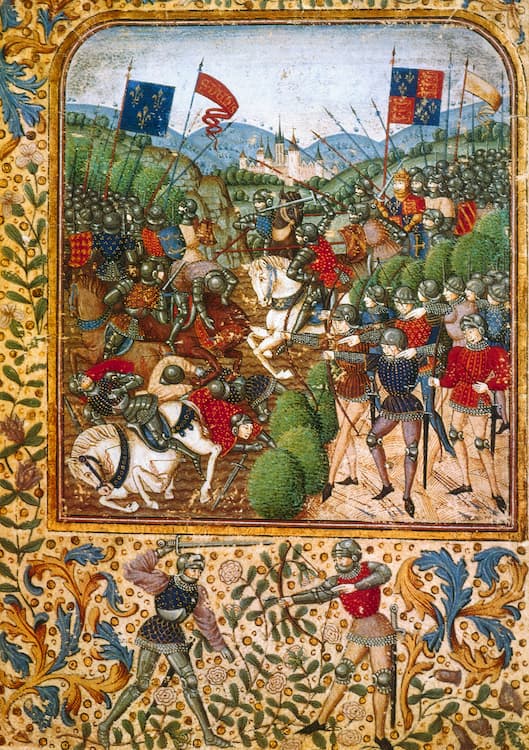
The Battle of Agincourt
During the siege, the French had raised an army which had assembled around Rouen, although it had been too late to relieve Harfleur. Thus began a game of cat and mouse as Henry tried to get ahead of the superior French force led by Jean Boucicaut, Marshal of France. Thwarted in his attempts to cross the Somme, Henry was forced to take his army south, away from Calais and deeper into France, before finally fording the river near Péronne. Supplies were scarce, and dysentery still plagued his remaining forces. The Dauphin called a semonce des nobles, summoning knights to set aside their factional differences and join the French army. Anticipating a turkey shoot, French noblemen turned up in droves in hope of battle honours and expecting to capture and ransom English knights, whose families under chivalric law would have to pay five years’ income from the captives’ estates. Perhaps, some dreamed, they might even capture the King himself. Princes, dukes, barons, counts, viscounts, and their retinues caused Boucicaut’s army to swell grotesquely, undermining his command. Although he would have preferred to avoid a confrontation, Boucicaut finally trapped Henry between the forests of Tramecourt and Azincourt (known erroneously as ‘Agincourt’ in English). The French had chosen the ground. English were sick, hungry, and exhausted, and outnumbered at least five to one, probably more. On the morning of October 25, the battle was joined.
At this point, the myth takes over:
This story shall the good man teach his son;
And Crispin Crispian shall ne’er go by,
From this day to the ending of the world,
But we in it shall be remember’d;
We few, we happy few, we band of brothers;
For he to-day that sheds his blood with me
Shall be my brother; be he ne’er so vile,
This day shall gentle his condition:
And gentlemen in England now a-bed
Shall think themselves accursed they were not here,
And hold their manhoods cheap whiles any speaks
That fought with us upon Saint Crispin’s day.
We all know the story. Henry’s tactical brilliance, the indomitable British fighting spirit, and the technological superiority of the longbow snatched an epic victory from the jaws of defeat. This noble battles echoes throughout history, still defining us as a nation over 600 years later. Henry’s call to arms in Shakespeare’s play makes every English heart swell with pride to this day. Before the Battle of the Nile, Nelson referred to his captains as his ‘band of brothers.’ When Churchill heard Lawrence Olivier deliver the ‘St. Crispin’s Day’ speech on radio he begged the actor to film the play to boost British morale. Generations of schoolchildren have memorised these lines; politicians still allude to them.
But what really happened? King Henry V
Henry’s limited forces were stuck in a bottleneck with a mile wide front shrinking to about 750 yards between two thick forests. Henry deployed defensively, with longbowmen on either flank, and men-at-arms and knights in the centre, led by Henry himself. The archers drove pointed wooden stakes into the ground at an angle to disrupt cavalry. A page of Boucicaut’s original battle plan survives and is held at the museum at Péronne. He had intended to first deploy archers and infantry with crossbows which may well have resulted in a very different outcome. Instead, lords and gentlemen demanded places in the front lines, drunk on thoughts of glory and profit and confident of an easy victory. The bulk of Boucicaut’s men-at-arms were therefore massed on the front lines, with no remaining space for the infantry, who had nowhere to go but the rear. When the undisciplined and disorganised French cavalry finally charged, it was a disaster.
Heavy rain the night before had turned the ground into a quagmire of sodden blue clay, the same mud that turned the Battle of the Somme into a slimy, sucking hellscape 501 years later. Heavy war horses struggled through the mud while their riders failed to flank the archers behind their stakes because of the trees. Horses bunched together, and while the English arrows were not very effective against the Italian and German armour the French knights wore, they tore into the horses, which panicked and tried to escape, running straight into the ranks behind them. Wounded and terrified horses galloped through the advancing infantry, scattering and trampling. It was chaos. The killing ground was also becoming lethally crowded. The French chronicler Michel Pintoin, the ‘Monk of St. Denis’, wrote of French soldiers ‘marching through the middle of the mud where they sank up to their knees. So they were already overcome with fatigue even before they advanced against the enemy.’ Worse, he continued, ‘Their vanguard, composed of about 5,000 men, found itself at first so tightly packed that those who were in the third rank could scarcely use their swords.’ Knights in heavy armour fell into the mud and suffocated or drowned as their comrades clambered over them. As the crush continued, the French second line pushed forward, further adding to the catastrophic press. It was not English pluck that defeated the French at Agincourt, but a tragic crowd disaster. The medieval Latin chronicle Gesta Henrici Quinti (‘Deeds of Henry the Fifth’) describes the nightmare scene: ‘For when some of them, killed when battle was first joined, fell at the front, so great was the undisciplined violence and pressure of the mass of men behind them that the living fell on top of the dead, and others falling on top of the living were killed as well.’ The English archers abandoned their longbows and attacked the stricken French with mallets, hatchets, and daggers, capturing and killing thousands.
The only French success was an attack on the lightly protected English baggage train, which Shakespeare turns into a war crime. As the Welsh Captain, Fluellen, says:
Kill the poys and the luggage! ’tis expressly
against the law of arms: ’tis as arrant a piece of
knavery, mark you now, as can be offer’t; in your
conscience, now, is it not?
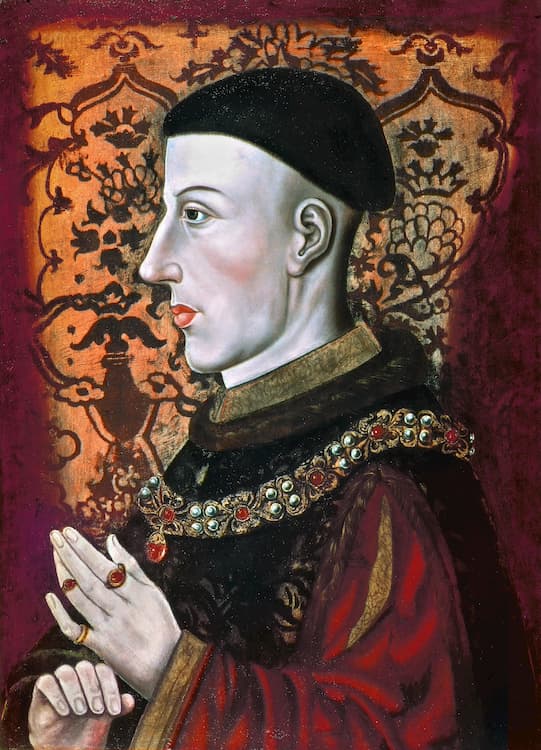
Henry V (1387-1422)
In fact, the real war crime of the day tends to be overlooked. Having captured several thousand high ranking French prisoners, Henry began to fear that he didn’t have the numbers to hold off a counterattack either by or to free the prisoners, who outnumbered their captors. These men had all surrendered under the sanctuary of parole, a chivalric code which guaranteed their safety until ransomed. Henry gave the order to execute them. When some of his knights objected, he threatened to hang any man that refused. Several thousand more Frenchmen died, many of them locked in a barn which was then set on fire. Shakespeare makes only a passing reference to these killings, omitting the grim details:
But, hark! what new alarum is this same?
The French have reinforced their scatter’d men:
Then every soldier kill his prisoners:
Give the word through.
This scene is immediately followed by Fluellen discovering the dead boys at the baggage train, presumably to morally justify the killing of the French prisoners. Perhaps Henry’s cause was not so ‘just’ nor ‘his quarrel honourable.’ The play is, of course, more nuanced that popular interpretation allows. It might be that it celebrates a great military victory, but Shakespeare also shows the cost of war, while depicting Henry sometimes as the noble king, sometimes the ruthless psychopath who hangs his old friends, threatens the people of Harfleur with rape, and murders his prisoners. King Henry V
The disaster at Agincourt left France in disarray, many of her military and political leaders killed off at a stroke. Entire noble bloodlines were wiped out. The surviving aristocratic families soon began fighting among themselves. Henry, meanwhile, did not have the forces for a military follow-through. He nonetheless returned to England in triumph, the English claim to Normandy advanced, and apparently ordained by God. The legitimacy of the Lancastrian monarchy was now guaranteed. The political chaos in France allowed Henry the time to prepare for a new campaign, and by 1419 he had conquered much of Normandy and Northern France. In 1420, Henry and Charles VI signed the Treaty of Troyes, recognising Henry as regent and heir to the French throne. He also finally married Catherine of Valois. Shakespeare relates these events in the fifth and final act of the play.
Henry was set to rule the kingdoms of England and France after the death of Charles VI, but he didn’t live to achieve this, dying on August 31, 1422, at the Château de Vincennes, some said of the Bloody Flux. Charles outlived him by only a couple of months, dying on October 21. Henry’s infant son became Henry VI of England, a regency formed by his uncles, John, Duke of Bedford, and Humphrey, Duke of Gloucester until he came of age. During Henry VI’s reign, most of the French territories captured by the English were lost to Charles VII of France, with only the outpost of Calais remaining. (Mary I finally lost it in 1558.) By 1453, the Hundred Years’ War was over, and England’s claim to the French throne with it. Henry VI’s heirs and descendants fell to quarrelling over the succession, leading to the War of the Roses. But that’s another story.
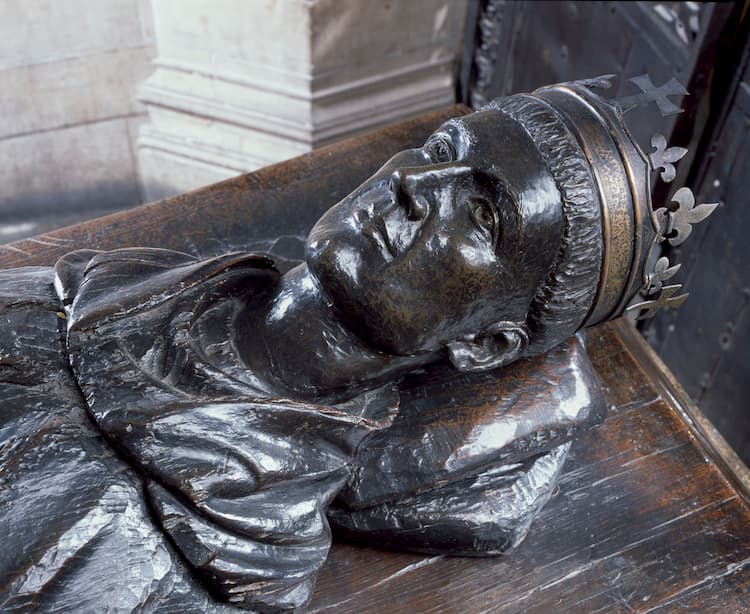
Tomb of Henry V, Westminster Abbey
Despite his early grave and the subsequent loss of the French territories, there can be no doubt that Henry V changed the course of British history, and he is rightly the stuff of national myth and legend. To all intents and purposes, even though Agincourt did not play out the way Shakespeare wrote it, we might even argue that it is still true, fact and fiction alchemically blending to form a new reality. Shakespeare’s Henry V, after all, wouldn’t be the first fictional character to change the world. That said, there is something satisfyingly random about the real Battle of Agincourt. It could all have been so different. I wonder if Henry ever acknowledged this to himself. It was not his military acumen, God’s will, or the heroism of his men that carried the day. It was blind luck.
Perhaps national identity, in the end, is rightly or wrongly based upon not looking too closely, especially at our heroes. We remain armour-plated against a reality that is often brutal and chaotic, protected by our stories, which endure after the facts are long forgotten. As Thomas Carlyle wrote in On Heroes, Hero-Worship and the Heroic in History (1841): ‘Hardened round us, encasing wholly every notion we form, is a wrappage of traditions, hearsays, mere words.’
Stephen Carver
Dedicated to the late Paul Cotton, whose work taught me so much about the real Battle of Agincourt.
Main image: Statue of the character Prince Hal (Henry V) and William Shakespeare on the apex of the Gower Monument, Stratford Upon Avon, England. Credit: Martin Bache / Alamy Stock Photo
Image 1 above: Laurence Olivier in the 1944 Rank/Two Cities film of Henry V. Credit: Pictorial Press Ltd / Alamy Stock Photo
Image 2 above: Kenneth Branagh in the 1989 Samuel Goldwyn film. Credit: Everett Collection Inc / Alamy Stock Photo
Image 3 above: Henry V at the Battle of Agincourt, 25 October 1415. Manuscript illumination, 15th century. Credit: Granger – Historical Picture Archive / Alamy Stock Photo
Image 4 above: Henry V (1387-1422). King of England, 1413-1422. Oil on panel by an unknown artist. Credit: Granger – Historical Picture Archive / Alamy Stock Photo
Image 5 above: Wooden effigy on the tomb of Henry V in Westminster Abbey. Credit: Angelo Hornak / Alamy Stock Photo
A short biography on the Royal website can be found here: Henry V (r. 1413-1422) | The Royal Family
Our editions of Henry IV Parts One and Two and Henry V can be found here: Henry IV Parts 1 & 2 and here: Henry V
King Henry V
King Henry V
King Henry V
Books associated with this article
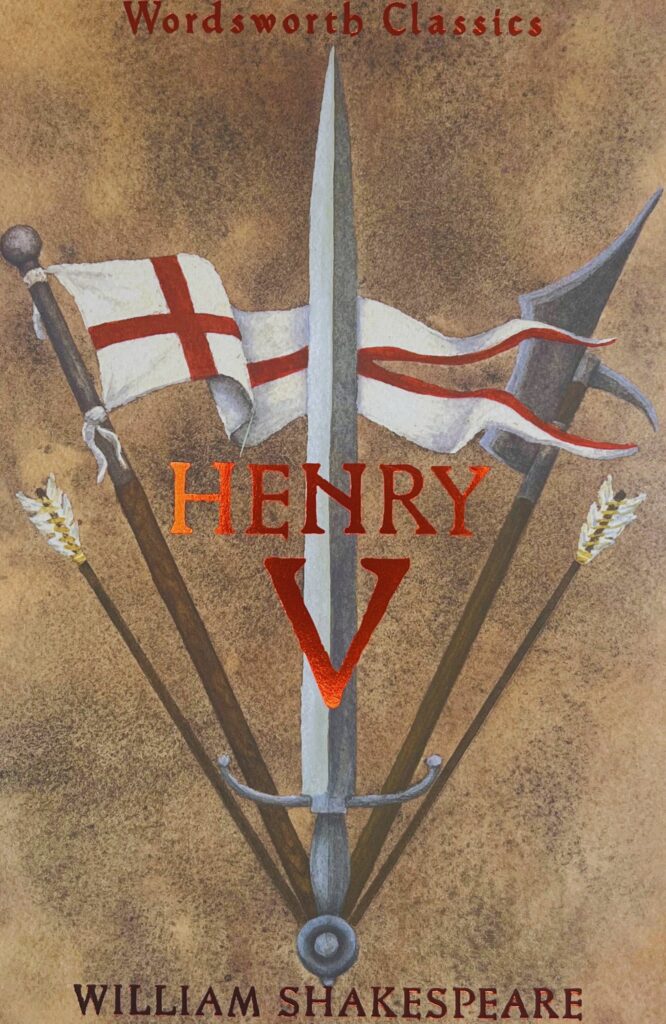
Henry V
William Shakespeare
